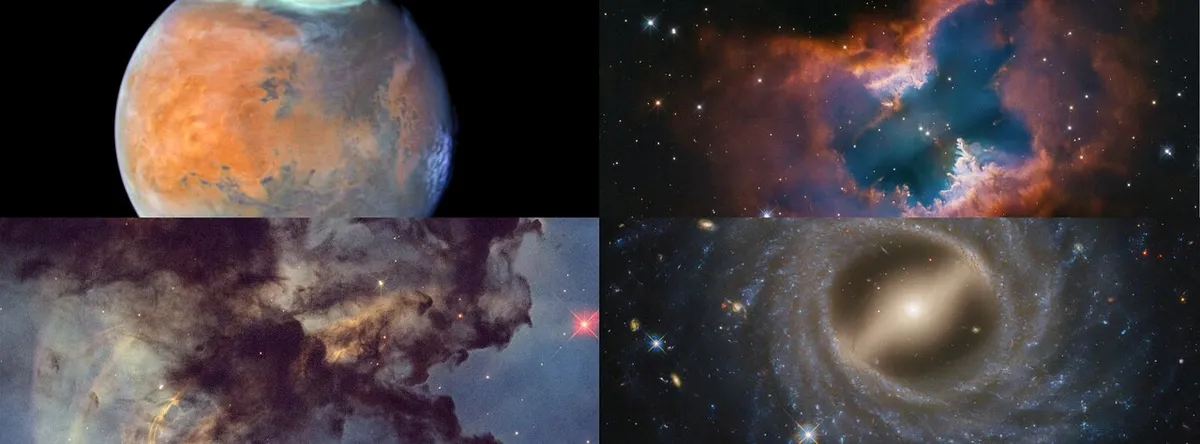
In a remarkable celebration of the NASA/ESA Hubble Space Telescope’s 35 years in Earth orbit, a stunning collection of recent images has been unveiled. These images range from the captivating planet Mars to breathtaking depictions of stellar birth and death, as well as views of a magnificent neighboring galaxy. For over three decades, Hubble has solidified its status as the most recognized telescope in the history of science, providing unparalleled insights into the universe.
Astronomers recognized that positioning a telescope above Earth’s murky atmosphere would revolutionize our view of the universe. Hubble’s vision offers a clarity ten times sharper than that of traditional ground-based telescopes. Its remarkable sensitivity enables it to detect objects with brightness levels over one billion times dimmer than the faintest stars visible to the naked eye. By observing the cosmos without atmospheric interference, Hubble captures a wide spectrum of wavelengths, from ultraviolet to near-infrared light, revealing stunning celestial phenomena.
Before Hubble's launch, the vast complexities of the universe were primarily left to human imagination. The telescope ignited humanity's quest to understand the cosmos, marking a pivotal point in the exploration of space. The early 1920s saw astronomer Edwin Hubble uncover galaxies beyond our Milky Way, setting the stage for the telescope that now bears his name.
Today, Hubble is at the forefront of scientific exploration, a testament to the dedication and ingenuity of engineers, scientists, and mission operators. Between 1993 and 2009, astronaut crews conducted five servicing missions to upgrade Hubble’s cameras, computers, and support systems. This collaboration has resulted in nearly 1.7 million observations of approximately 55,000 astronomical targets, leading to >22,000 published papers and over 1.3 million citations as of February 2025. The wealth of data collected by Hubble now exceeds 400 terabytes, and the demand for observing time remains exceptionally high, with a 6:1 oversubscription rate, solidifying its status as one of the most sought-after observatories in existence.
Hubble’s extensive operational life has allowed astronomers to witness significant changes in the universe over three decades. From seasonal variations on planets within our solar system to the dynamics of black hole jets moving at nearly the speed of light, Hubble continues to unveil the mysteries of the cosmos, including stellar explosions, asteroid collisions, and expanding supernova remnants.
Hubble’s legacy serves as a bridge between our historical understanding and future knowledge of an awe-inspiring universe filled with colliding galaxies, ravenous black holes, and spectacular stellar phenomena. The telescope has illuminated many concepts within modern astrophysics, including microlensing, time-dilation, and the existence of gravitational waves. Before its launch in 1990, powerful optical telescopes could only glimpse half of the cosmos, leading to significant discrepancies in estimations regarding the age of the universe.
Among Hubble's numerous breakthroughs, its deep-field observations have revealed countless galaxies dating back to the early universe, precisely measured cosmic expansion, and confirmed the prevalence of supermassive black holes in galaxies. The telescope has also played a crucial role in identifying dark energy, which is driving the universe's accelerated expansion.
After three decades, Hubble remains a household name, celebrated as the most recognized and impactful scientific instrument in human history. The captivating images and discoveries made by Hubble have transformed public perception of the cosmos, making astronomy more relevant and accessible to people of all ages. Hubble has truly become “the people’s telescope,” resonating emotionally with millions around the world.
Each Hubble snapshot captures the universe's beauty and complexity, evoking a sense of wonder and curiosity about our place in the cosmos. These iconic images have become timeless symbols of scientific exploration and the human drive to seek understanding.
In honor of its 35th anniversary, NASA and ESA have released a selection of striking images taken by Hubble, showcasing targets ranging from planets to nebulae and galaxies:
Mars: A combination of images taken between December 28th and 30th, 2024, shows Mars approximately 98 million kilometers from Earth, with thin water-ice clouds giving the planet a frosty look as it welcomes the onset of Martian spring. Planetary Nebula NGC 2899: This nebula features a unique diagonal, bipolar outflow of gas propelled by radiation and stellar winds from a hot white dwarf at its center, adorned with colorful glowing hydrogen and oxygen. Rosette Nebula: A small segment of this vast star-forming region reveals dark clouds of hydrogen gas shaped by radiation from a cluster of stars, producing stunning colors indicative of various elements. Barred Spiral Galaxy NGC 5335: This flocculent spiral galaxy lacks well-defined arms, showcasing a notable bar structure that channels gas towards its center, fueling star formation.Despite its impressive age of 35, Hubble's research and discoveries continue to flourish. Astronomers, particularly from Europe, actively utilize the telescope, often exceeding the 15% observing time guaranteed by ESA's participation in the Hubble mission. This collaboration has led to significant discoveries, such as evidence of intermediate-mass black holes and new insights into the early universe.
A highlight of Hubble's recent achievements was the discovery of Earendel, the most distant single star observed to date, seen at a time when the universe was less than a billion years old. Hubble's long operational life has also allowed for comprehensive studies of our solar system's outer planets, revealing critical information about moons and asteroids, including the asteroid Dimorphos.
Furthermore, Hubble has maintained its relevance in exoplanet research, studying atmospheric conditions and even discovering new atmospheres around rocky exoplanets. Recent analysis of supernova host galaxies has allowed for the most accurate measurements of the Hubble constant to date, while the largest photomosaic of the Andromeda Galaxy has been completed after a decade of Hubble observations.
The Hubble Space Telescope has been a beacon of scientific discovery for over three decades, continuing to shape our understanding of the universe. It stands as a symbol of international cooperation between NASA and the European Space Agency, with ongoing support from various scientific institutions. As Hubble continues to explore the cosmos, its legacy will undoubtedly inspire future generations of astronomers and space enthusiasts alike.
Image Credit: NASA, ESA, STScI